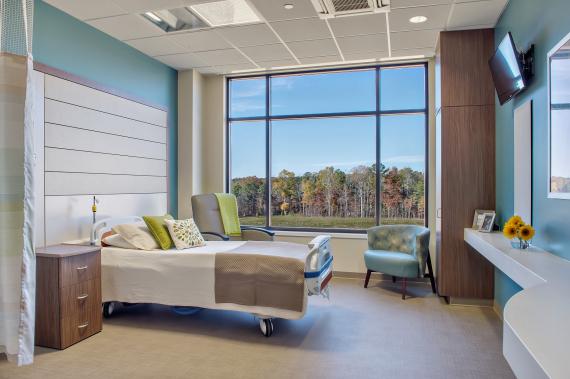While the architectural design of the building is probably not top of mind while sitting in a hospital emergency room or resting in labor & delivery, a lot of decision-making goes into ensuring that a patient’s stay is as pleasant and comfortable as possible. In a situation where minutes can mean life or death, the general layout of a hospital is critical to ensuring patients and hospital staff can move efficiently through the building.
Traditional hospital design, however, leaves a lot to be desired. The hallmark “hospital smell,” plain walls and brightly lit hallways can feel cold and unwelcoming. Although, more recently in the design and construction of hospitals, there has been a trend toward visual healing with the incorporation of natural light, outdoor gardens and better dining options. Studies have shown that modern facility accommodations and so-called extra amenities tend to evoke more confidence in the care that will be received and overall stronger patient satisfaction.
Architectural Design Provides Measurable Results
It’s not all just aesthetics though. McGill University, located near Montreal in Canada, renovated its facility to eliminate shared intensive care unit rooms. Most patients prefer the privacy of separate rooms and it also led to a decrease in the spread of bacterial infection by 50%.
Incorporating more windows into a building’s exterior can increase the construction and energy costs, as well as the maintenance requirements for the facility. Recovering patients, however, have proven to respond more positively—from reduced stress to higher pain tolerance—to views of the outside environment versus the sterile hospital walls. It is for this reason that hospitals have taken a more cost-effective approach and begun to integrate gardens or atriums filled with natural plants for patients and their families to access freely.
An acute psychiatric unit in the United States took steps to creating a more inviting lounge space by decorating the traditionally bland walls with realistic scenes of nature. Within a few weeks, there was a noticeable change in the behavior of the patients and a 70% decrease in as-needed injections. Less as-needed injections administered meant a savings of nearly $30,000 in drug costs. So while these extra amenities may require a larger upfront construction cost, the expenditure has been deemed beneficial to both patients and hospital personnel in the long-run.
Photo courtesy of www.healthcaredesignmagazine.com
NEXT STEPS:
- Visit our blog for the latest industry news
- Follow us on Twitter, Facebook or LinkedIn
- For more on the various levels of bullet resistance, download this free fact sheet.


